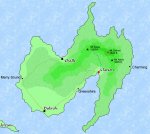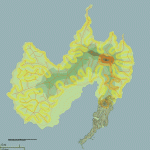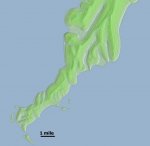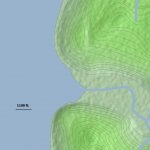Michael Morris
First Post
Hey everyone. I've been away awhile, working on somethings, gearing up for my next big project. I'm going to go over process in here and I'm looking for tips and pointers. Of course if you just want to look at maps be sure to look at the ones near the end as they are the complete ones.
After neglecting my own setting for some 5 years now I'm currently taking a very hard look at it, doing some massive revisions, and one of the places I'm starting with is the maps. I'll start with showing a section of the map I've used now for 7 years - the island of Mahn and the tiny nation of Dabrinia.

Quaint by today's standards isn't it? And while it may look ok, what's the scale? At the time I made that map I really didn't have a sense of proper scale but experiences in the interceding years have forced me to resize things down to something believable.
You see, I've ran into Google Maps and every time I play with it, study it, I can't help but think - this is how to present a map. So I'm going to write custom software that works similar to Google Maps, though not as sophisticated. The first part is drawing maps that fit in with that scale.
Take a look on the map above at the long southeastern peninsula of the island. After studying earth and in particular Japan since it is the closest geological match to Telzoa - the final preview I'm going to show is there. Pretty nondescript.
Anyway, I focused in on Hokkaido, the north island, for geological inspiration. I need to build a map that can scale from approx 1" = 100 miles, down to the per feet level. Rather than go insane trying to do all of Telzoa, I decided to start with Dabrinia since it is, relatively, small. I started first by superimposing the continental map established for the setting against Earth to establish precisely and for the first time what my scale ought to be. I was -- ahem -- off, what was distances of 40 miles are now 2 miles apart. Several major cities are going to need to be downsized.
I next took Dabrinia, cut it away from the original continental map in CC3, placed it in Fireworks 8 and, using the pen tool, drew this monstrosity.

One thing I realized in studying Hokkaido is mountain ranges can and do go right up to the sea - indeed as much as 60% of its coastline is mountainous. The red contour lines are "pilot" lines, marking 1000' changes in elevation. The second thing I noted in studying real geology is even a small volcanic island can crest out in the 8000-10,000 range, so the conservative 3000 marks of the original Dabrinian mountains are right out - further they're too close to each other at the new scale.
The brown lines in the map above are spines - dividing points where water flows from. With this in hand I started drawing the rest of the contour lines at 200' intervals.
I hit a problem in a couple of discarded drafts in that I didn't allow for the spacing of the lines. With some practice I figured out what that would be and created a second draft map.

The yellow lines are thick enough to make clear how much space the first 2000' worth of contour lines need, at a minimum. I use this to then map out wher the canyons of the island will go. Orange lines serve the same purpose for 2000-4000'. Anything higher than that will be part of a volcanic cone as on Hokkaido.
This morning I decided to make sure all this contouring was going to work and I began to practice how to make the contour map into a height map for use with Photoshops light rendering tools. After most of the day's experimentation, this is what I came up with.

And then since the contours exist as vectors I was able to create this zoom map in 2 minutes. At that scale 1 pixel = 11 feet - meaning house and boat shapes should be clearly visible on village maps that share a common scaling system with the regional maps.

Over the next couple weeks I'll finish Dabrinia, then cut it up into pieces to start writing the mapping software around. Wish me luck - this promises to be difficult.
After neglecting my own setting for some 5 years now I'm currently taking a very hard look at it, doing some massive revisions, and one of the places I'm starting with is the maps. I'll start with showing a section of the map I've used now for 7 years - the island of Mahn and the tiny nation of Dabrinia.

Quaint by today's standards isn't it? And while it may look ok, what's the scale? At the time I made that map I really didn't have a sense of proper scale but experiences in the interceding years have forced me to resize things down to something believable.
You see, I've ran into Google Maps and every time I play with it, study it, I can't help but think - this is how to present a map. So I'm going to write custom software that works similar to Google Maps, though not as sophisticated. The first part is drawing maps that fit in with that scale.
Take a look on the map above at the long southeastern peninsula of the island. After studying earth and in particular Japan since it is the closest geological match to Telzoa - the final preview I'm going to show is there. Pretty nondescript.
Anyway, I focused in on Hokkaido, the north island, for geological inspiration. I need to build a map that can scale from approx 1" = 100 miles, down to the per feet level. Rather than go insane trying to do all of Telzoa, I decided to start with Dabrinia since it is, relatively, small. I started first by superimposing the continental map established for the setting against Earth to establish precisely and for the first time what my scale ought to be. I was -- ahem -- off, what was distances of 40 miles are now 2 miles apart. Several major cities are going to need to be downsized.
I next took Dabrinia, cut it away from the original continental map in CC3, placed it in Fireworks 8 and, using the pen tool, drew this monstrosity.

One thing I realized in studying Hokkaido is mountain ranges can and do go right up to the sea - indeed as much as 60% of its coastline is mountainous. The red contour lines are "pilot" lines, marking 1000' changes in elevation. The second thing I noted in studying real geology is even a small volcanic island can crest out in the 8000-10,000 range, so the conservative 3000 marks of the original Dabrinian mountains are right out - further they're too close to each other at the new scale.
The brown lines in the map above are spines - dividing points where water flows from. With this in hand I started drawing the rest of the contour lines at 200' intervals.
I hit a problem in a couple of discarded drafts in that I didn't allow for the spacing of the lines. With some practice I figured out what that would be and created a second draft map.

The yellow lines are thick enough to make clear how much space the first 2000' worth of contour lines need, at a minimum. I use this to then map out wher the canyons of the island will go. Orange lines serve the same purpose for 2000-4000'. Anything higher than that will be part of a volcanic cone as on Hokkaido.
This morning I decided to make sure all this contouring was going to work and I began to practice how to make the contour map into a height map for use with Photoshops light rendering tools. After most of the day's experimentation, this is what I came up with.

And then since the contours exist as vectors I was able to create this zoom map in 2 minutes. At that scale 1 pixel = 11 feet - meaning house and boat shapes should be clearly visible on village maps that share a common scaling system with the regional maps.

Over the next couple weeks I'll finish Dabrinia, then cut it up into pieces to start writing the mapping software around. Wish me luck - this promises to be difficult.
